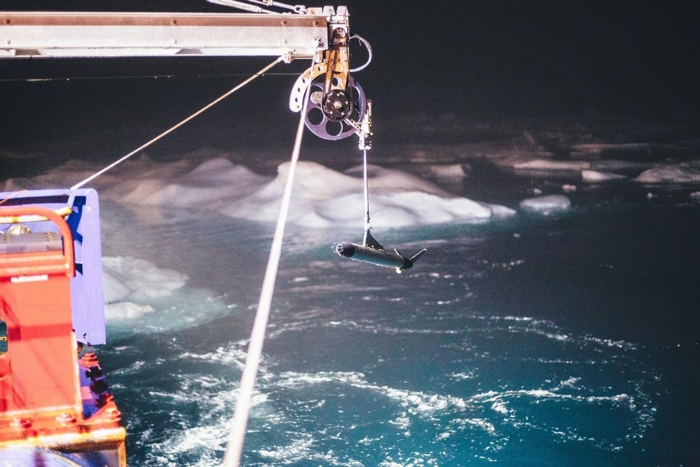For decades, warmer waters seeping into the Arctic Ocean have increasingly threatened Arctic sea ice, with scientists predicting the ice pack could disappear entirely in summers from the middle of the next decade.
Researchers have now uncovered one of the mechanisms driving this catastrophe, identifying how 'heat bombs' of warm, salty water from the Pacific Ocean flow into the frigid Arctic Ocean, heating the ice above from underneath for months or even years.
"The rate of accelerating sea ice melt in the Arctic has been hard to predict accurately, in part because of all of the complex local feedbacks between ice, ocean, and atmosphere," says physical oceanographer Jennifer MacKinnon from the Scripps Institution of Oceanography at UC San Diego.
"This work showcases the large role in warming that ocean water plays as part of those feedbacks."
These swirling heat bombs can last for months to years, moving far north beneath the main ice pack near the north pole, destabilizing that ice as the heat in them gradually but steadily diffuses upwards. pic.twitter.com/yPABP7uPg9
— Scripps Institution of Oceanography (@Scripps_Ocean) April 23, 2021
In 2018, MacKinnon visited the Arctic Ocean as the chief scientist of a research expedition aboard RV Sikuliaq as part of Stratified Ocean Dynamics of the Arctic (SODA), a multi-institutional project funded by the US Office of Naval Research.
One of the goals was to learn more about how warmer flows of water from the Pacific Ocean enter the Arctic Ocean by way of the Bering Strait, bringing with them "unprecedented quantities of heat" that extend hundreds of kilometers into the Beaufort Gyre, a giant ocean current north of the Alaskan and Canadian coasts.
 A dast CTD (conductivity-temperature-depth) system deployed during the 2018 SODA cruise in the Arctic Ocean. (San Nguyen)
A dast CTD (conductivity-temperature-depth) system deployed during the 2018 SODA cruise in the Arctic Ocean. (San Nguyen)
"This Pacific-origin water brings both heat and unique biogeochemical properties, contributing to a changing Arctic ecosystem," the researchers explain in their new study.
"However, our ability to understand or forecast the role of this incoming water mass has been hampered by lack of understanding of the physical processes controlling subduction and evolution of this warm water."
Thanks to the SODA expedition and its gamut of scientific measurements – including satellite imagery analysis and a range of in-water readings from submersible sensors and vehicles – the physics are now much less of a mystery.
According to the team's new observations, the salty, denser Pacific Summer Water (PSW), which the team likens to a "warm jet in a cold ocean", slides underneath the cooler, fresher Arctic Ocean waters at the surface, via a process of subduction.
As the meandering jet flows into the gyre, pockets of warmer water – nicknamed 'heat bombs' – wedge below the fresher waters above, becoming vertically compressed and breaking up into smaller, spinning eddies.
"Though some heat is lost to the atmosphere, the vast majority subducts to be sequestered from direct contact with the atmosphere, and subsequently stirred and spread sub-surface toward the central basin," the authors write.
In addition to the long-term melting effects provided by these heated eddies to the sea ice cover overhead, the ingress of Pacific waters also introduces a mixture of organic and chemical matter to the Arctic environment, the impacts of which are still ultimately unknown.
While these new insights will help us develop better models to more accurately predict the physics underpinning future changes to Arctic sea ice, in the simplest terms, the near-term forecast is already determined.
"As the heat content of PSW is growing, the combination of PSW subduction, lateral stirring, and upward vertical mixing should lead to a pattern of accelerating sea ice melt spreading out from the Pacific inflow, as has been observed in recent decades," the team concludes.
The findings are reported in Nature Communications.
#Environment | https://sciencespies.com/environment/dangerous-heat-bombs-have-been-entering-the-arctic-ocean-expedition-reveals/
No comments:
Post a Comment